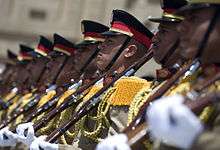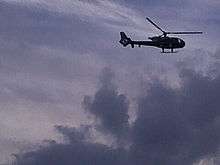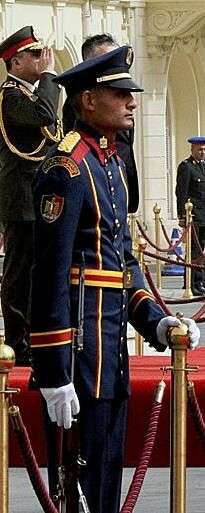Republican Guard (Egypt)
| Egyptian Republican Guard | |
|---|---|
| El-Haras el-Gomhoury | |
 El Haras el Gomhoury | |
| Active | 1955 – present |
| Country |
|
| Allegiance | Egyptian Armed Forces |
| Branch | Egyptian Army |
| Type | Praetorian Guard |
| Role | Armoured |
| Size | 24,000 active duty troops |
| Part of | Armored Corps |
| Garrison/HQ | Heliopolis |
| Engagements |
Six-Day War Yom Kippur War |
| Commanders | |
| Current commander | General Mohammed Zaki |
| Notable commanders |
Mohammed Hussein Tantawi Mohsen Fangary |

The Egyptian Republican Guard is a Division level command within the Egyptian Army, designed to be an armored division with the main responsibility to defend the President of the Republic, the major presidential and strategic institutions, including the Presidential Palaces, Command centers, presidential airports. It is one of the largest Divisional commands in Egypt with a heavy emphasis on Armoured and Mechanized warfare. It is the most senior Corps in the Egyptian Army. The Republican Guard is the only division in the Egyptian Armed Forces that receives commands only from its commander and the president not from the Supreme Council of the Armed Forces led by the minister of defense.
Organization
The Republican Guard is under the direct command of the Ministry of Defense. Its current commander is General Mohammed Zaki. The Republican Guard Division is the only significant military unit allowed in central Cairo, apart from the intelligence services’ military branches and Central Security.
History

It was created subsequent to the Egyptian Revolution of 1952 by Gen. Mohammad Laithi Nassif (1922 - 24 August 1973), on the instructions of Egypt's second President, Gamal Abdel Nasser. Its tasks were to protect the Presidency, and the national government in Cairo. Known originally as the National Guard, it was mainly a paramilitary force, but was expanded into a large military force, first at a brigade level in the 1950s and 1960s, then augmented at a division level and incorporated under the Armored Corps in 1985.
Secondary duties are to protect presidential sites and important State buildings in Cairo, provide Honor Guard and security services for the highest national personalities and important foreign guests; and responding to any rebellion, coup, or other threat to the government of the Republic.
Members are mainly but not exclusively volunteers on deputation from other Army units, mainly armored and mechanized units, who receive bonuses and subsidized housing, and received greater training than the regular army. The Egyptian Republican Guard, however, doesn't recruit directly from the population, unlike their Syrian, Yemeni, and (formerly) Iraqi counterparts. The bulk of its troops are recruited from other Army units, mainly on the basis of performance and advanced training in urban and other types of modern warfare.
Generally components of one or more Brigades under the Guard have been deployed to forward divisions on Egypt's eastern and western borders.
It is mainly equipped with M 60 and M1A1 Abrams tanks, and the BMP-2 and M-1117 armoured fighting vehicles. There are several Anti-Tank infantry platoons as well, equipped with the AT-3 Sagger and BGM-71 TOW anti-tank guided missiless. They were initially trained by the Soviet Army in the 1950s and 1960s.
The Military Police battalions of the Republican Guard have often been deployed as conventional Riot Police armed with teargas, water cannons and batons, especially during civil unrest targeting key Defence installations and buildings.
Republican Guard 2013 events
At dawn on July 8, 2013, a series of clashes erupted between Republican Guard soldiers and protesters who demanded the return of the former President Mohamed Morsi to power following the 2013 Egyptian coup d'état. This led to at least 57 deaths abd 435 injuries.
Organization
| Part of a series on |
| Armed Forces of the Arab Republic of Egypt |
|---|
| Administration |
| Service branches |
| Armies and Military Areas |
| Special Forces |
| Ranks of the Egyptian Military |
| History of the Egyptian military |
The Republican Guard Division is located for administrative purposes under 1st Corps, which has its Field H.Q. in Heliopolis, Cairo, Central Military Region. In turn, 1st Corps is part of First Field Army also with its H.Q. in Cairo.[1]
Field organization
HQ Republican Guard Armored Division (aka 1st Republican Guard Armored Division)
- Armored brigades
- 2 Armored Brigades (33rd & 35th)
- 4 Armored Battalions (118th, 119th, 120th, 121st)
- 16 Armored Companies
- 4 Command Companies
- 2 Military Police Companies
- 4 Signal/Recon Companies
- 2 Mechanized Battalions (41st & 42nd)
- 8 Mechanized Companies
- 2 Command Companies
- 2 Signal/Recon Companies
- 2 Anti-Tank Companies
- 4 Armored Battalions (118th, 119th, 120th, 121st)
- 2 Armored Brigades (33rd & 35th)
- Mechanized Brigades
- 2 Mechanized Brigades (510th & 512th)
- 6 Mechanized Battalions (41st, 42nd, 43rd, 44th, 45th, 46th)
- 18 Mechanized Companies
- 3 Command Companies
- 2 Military Police Battalions
- 3 Signal/Recon Companies
- 2 Armored Battalions (116th & 117th)
- 6 Armored Companies
- 1 Command Company
- 1 Anti-Tank Company
- 1 Signal/Recon Company
- 6 Mechanized Battalions (41st, 42nd, 43rd, 44th, 45th, 46th)
- 2 Mechanized Brigades (510th & 512th)
- RG Divisional Artillery
- 1 S/P Artillery Brigade (10th) Command H.Q. (Brigade level)
- 4 S/P Artillery Battalions (1st to 4th)
- 16 S/P Artillery Batteries
- 4 S/P Artillery Battalions (1st to 4th)
- 1 S/P Artillery Brigade (10th) Command H.Q. (Brigade level)
Uniform and Insignia

The Republican Guard has a distinctive uniform different from that of the regular Egyptian Army. The service uniform of the Guards is of a tan color with a distinctive blue beret and epaulets. A blue-grey parade uniform is worn by honor guard and other ceremonial detachments. The Military Police battalions wear a red beret, with a red colored helmet when deployed in riot control duties.
Uniform
 |
 |
 |
 |
|---|---|---|---|
| Everyday suit | Republican Guard Police Forces | Field outfit | Camouflage outfit |
Berets
| Beret | ||
|---|---|---|
| Officer | Brigadier General | General |
 |
 |
 |
References
- ↑ See Order of Battle at "Archived copy". Archived from the original on 2009-10-26. Retrieved 2009-10-07. , accessed August 2009
See also
| Wikimedia Commons has media related to Military of Egypt. |